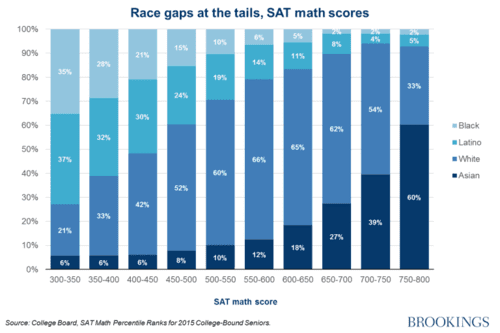
By Steve Sailer
02/04/2017
From the Democratic Party-oriented Brookings Institution:Race gaps in SAT scores highlight inequality and hinder upward mobilityI’ve been following test scores for 45 years now the way other guys follow baseball statistics. But it’s kind of boring because nothing much changes, other than the ever-growing Asian dominance at the high end.Richard V. Reeves and Dimitrios HalikiasWednesday, February 1, 2017
… Race gaps on the SATs are especially pronounced at the tails of the distribution.among top scorers — those scoring between a 750 and 800 — 60 percent are Asian and 33 percent are white, compared to 5 percent Latino and 2 percent black. Meanwhile, among those scoring between 300 and 350, 37 percent are Latino, 35 percent are black, 21 percent are white, and 6 percent are Asian. …
Disappointingly, the black-white achievement gap in SAT math scores has remained virtually unchanged over the last fifteen years.The gap was narrowing in recent years, but then it got wider the last two years.
Between 1996 and 2015, the average gap between the mean black score and the mean white score has been .92 standard deviations. In 1996 it was .9 standard deviations and in 2015 it was .88 standard deviations. …Some of this is driven by programs to get more kids to take the SAT in the hopes of finding a few overlooked high scorers, but of course giving out free tests to poor kids mostly just expands the number of lower to middling scorers.
But, overall, the stability of the race gaps is pretty remarkable. They appear to be more persistent than, say, height gaps. The entire topic deserves a broader investigation than it has gotten.
There are some limitations to the data which may mean that, if anything, the race gap is being understated. The ceiling on the SAT score may, for example, understate Asian achievement. … A standardized test with a wider range of scores, the LSAT, offers some evidence on this front. An analysis of the 2013-2014 LSAT finds an average black score of 142 compared to an average white score of 153. This amounts to a black-white achievement gap of 1.06 standard deviations, even higher than that on the SAT.The SAT is, more or less, the Blue State college admissions test, so it gets more publicity. But the ACT, the Red State test, has overtaken the more famous SAT in numbers taking it. The gaps are similar on both, however.
The black-white achievement gap for the math section of the 2015 SAT was roughly .88 standard deviations. For the 2016 ACT it was .87 standard deviations. Likewise, the Latino-white achievement gap for the math section of the 2015 SAT was roughly .65 standard deviations; for the 2016 ACT it was .54 standard deviations. …You often hear that racial gaps are really class gaps. To some extent that’s true, but people shouldn’t be so smug about asserting that:
However, a 2015 research paper from the Center for Studies in Higher Education at the University of California, Berkeley shows that between 1994 and 2011, race has grown more important than class in predicting SAT scores for UC applicants. While it is difficult to extrapolate from such findings to the broader population of SAT test-takers, it is unlikely that the racial achievement gap can be explained away by class differences across race.Also from Brookings:
Race gaps in SAT math scores are as big as ever[Comment at Unz.com]Richard V. Reeves Wednesday, February 1, 2017
This is a content archive of VDARE.com, which Letitia James forced off of the Internet using lawfare.